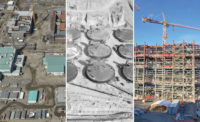Crews at the U.S. Energy Dept.’s Hanford nuclear-waste site in Washington state have placed the first of six massive, 50-ton shield doors at the site’s high-level waste treatment facility with a fit no wider than a human hair, say officials of San Francisco-based Bechtel National Inc., design-contractor for the $12.2-billion project on the 560-sq-mile site.


The shield door is in a key area of the 65-acre plant complex, which, when completed, will vitrify high-level nuclear waste now stored at the Hanford site in 144 aging and deteriorating underground storage tanks. More than 53 million gal of waste is left from the production of plutonium dates to the development and manufacture of the first atomic weapons at the complex during World War II.
The steel shield door is 8 in. thick and measures 15 ft tall and 18 ft wide. It was installed in the “melter area,” which is the core of the plant’s high-level waste facility. When operational, it will use two identical, 90-ton melters to heat the high-level waste and glass-former mixture to 2,100° F, according to Bechtel officials. The molten waste-and-glass mixture then will be poured into stainless-steel canisters, sealed and prepared for storage and, ultimately, disposal.
“We installed the doors using precision optics and verified the installation with a laser tracker,” says Scott Neubauer, Bechtel’s superintendent for the facility, “This technology is one of the few that provides accurate measurements to the precision this project requires.” The laser tracker used was originally developed for and used in high-precision applications in the aerospace industry, according to company officials.
Each high-level waste melter is designed to last five years, says Bechtel. At the end of the melter’s lifespan, it will be encased in a 250-ton, 8-in.-thick protective container, removed from the melter area and replaced with a new melter. The operation will be “safely accomplished using a sophisticated, remotely operated rail-and-airlock system, which will ensure workers are protected,” says a company official.
The system includes six airlock shield doors, three for each melter. The doors will open and close sequentially when the transfer is taking place. When the melter is safely encased in the protective container, it will be moved out of the facility for permanent storage.
The recently installed shield door is the first of the rail-and-airlock system’s shield doors and one of the two that will be closest to the melter itself. “By completing this first installation, we are setting the stage for the subsequent installations and ultimately for the entire [waste treatment plant] becoming operational in 2019,” says Neubauer.
The project is now half complete, officials say. All six shield doors are scheduled to be installed by the end of 2010, according to a Bechtel spokeswoman at the site.
Completion of the first installation came just days before high winds shut down some construction and other operations at the site and sent many workers home on May 4, officials say. Wind speeds were up to 60 mph, with one gust recorded at 100 mph at the top of a 3,000-ft-high hill on the edge of the site, according to a spokeswoman.





